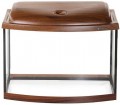Shape
The shape of the aquarium primarily determines its appearance and suitability for installation in a particular location. Accordingly, when choosing according to this indicator, it is quite possible to focus on your own aesthetic preferences, the design of the room in which the aquarium will be located, as well as the features of the installation location. At the same time, for some types of aquarium “live”, there are specific recommendations for the optimal shape: for example, spherical containers are poorly suited for bottom and benthic inhabitants due to the small bottom area. Therefore, before choosing a form, it will not hurt to also decide on the “population” and clarify the conditions that are optimal for the selected types of animals and plants.
- Parallelepiped. The classic shape, also colloquially called
“rectangular” : all the edges of such an aquarium are flat and truly represent rectangles. Such containers are easy to produce and inexpensive, but at the same time they are quite versatile, suitable for almost all types of flora and fauna, and many professional aquarists prefer rectangles.
—
Cube. In essence, these aquariums are a variation of the parallelepipeds described above, with the difference that the height, width and depth of the container in this case are the same. Cubes are a rather specific variety; they are rare and usually have a small volume (up to one fish t
...ank).
- Sphere. Round aquariums, usually all-glass (see “Design”). For installation, either a special stand or a small plane at the base of the “can” can be used, which also plays the role of the bottom. The size of this plane is small, which, on the one hand, allows you to place the aquarium on small platforms (much smaller than the size), on the other hand, it makes it difficult to keep fish that require a large area on the bottom. In addition, the volume of round models usually does not exceed a couple of tens of liters, which makes it difficult to maintain the necessary microclimate; and curved glass creates distortion in viewing.
— Oval. Oval aquariums are similar in shape to parallelepipeds (see above), except that the front wall is made convex. This improves visibility and visually increases the size of the aquarium, and from the point of view of overall design, such models are sometimes more preferable than “rectangles” (although they are somewhat more expensive).
- Hexagonal. Another modification of parallelepiped aquariums (see above): usually a hexagonal tank looks as if the two front corners of a rectangular aquarium were cut off, adding two additional edges. Like the oval ones described above, these “cans” provide better visibility and have an original appearance; however, this appearance is much rougher and does not fit into every interior, so hexagonal aquariums are less common.
- Semicircle. The aquarium is in the shape of a half cylinder - the back wall is flat, and the other wall is made in the form of a solid semicircular surface. This not only gives the container an original appearance, but also provides equally convenient visibility from almost any direction within 180°. On the other hand, semicircular aquariums are not cheap, and there is relatively rarely a real need for such a shape.
- Pentagonal. Pentagonal aquariums are usually designed to be installed in a corner: the two back walls meet at right angles and, when installed, are closely adjacent to the walls of the room, with three more edges located between them. This provides better visibility than corner aquariums (see below) with a flat front wall; and the advantage over corner models with a curved front wall is their slightly lower cost.
- Corner. This category includes all aquariums intended for installation in a corner and not classified as pentagonal (see above). A common feature of all corner models is two flat back walls, installed at an angle of 90° to each other; the front part can be flat, concave, multifaceted, etc.Volume
The nominal volume of the aquarium is one of the key indicators when choosing it.
The larger the "bank" — the more fish and other living creatures can be settled in it, the better it is suitable for large inhabitants. At the same time, professional aquarists proceed from the fact that “there is never a lot of volume” — after all, even the largest of home aquariums are much smaller than natural reservoirs. Therefore, when choosing by volume, usually, we are talking about the minimum required capacity. It can be found out by determining the planned composition and number of the "population" and specifying the conditions for their maintenance — data on this can be found in special sources.
In addition, the value of the volume lies in the fact that the larger the aquarium, the easier it is to maintain a constant microclimate in it, the less it is subject to temperature fluctuations due to changes in environmental conditions. Therefore, beginner aquarists are not recommended to purchase small containers — they require special care in maintaining the temperature.
Also note that the volume can be specified in different ways. So, some manufacturers consider the capacity in terms of dimensions and give the full volume, others — the working volume (that is, the maximum amount of water that makes sense to pour in fact), others — the required amount of water, taking into account the soil and decorations supplied in the kit, etc. P. However, more often than n...ot, the differences between models with the same claimed volume are very small.
Glass thickness
The thickness of the glass used in the aquarium. Strength and reliability directly depend on this indicator, therefore, in general, the thicker the glass, the better. On the other hand, manufacturers typically select thicknesses that are guaranteed to withstand the stresses of normal use. Therefore, you should pay attention to this parameter only if the glass seems too thin — for verification, it is best to compare the aquarium with models similar in volume and glass composition.

